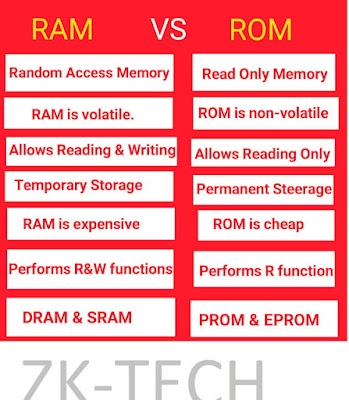What is RAM and ROM? Types of RAM and ROM ! Full Details in one ZK-TECH
On this page we will read about RAM and ROM. Basic Types Of RAM and ROM. It's abbreviations. Different between RAM and ROM. FAQ's about RAM and ROM.
What is RAM?
RAM is stands for Random-Access-Memory. Random access means that each individual byte in entire memory can be accessed directly. RAM is used to store instructions temporary.
RAM is a volatile memory. it means that its contents are lost when the power is turn off. RAM is a read/write memory. It is used to store data and instruction while it is being executed.
Types of RAM
 |
| Types Of RAM And ROM |
1) DRAM
2) SRAM
1) DRAM
DRAM stands for Dynamic Random Access Memory.. It is the not high price kind of RAM.
DRAM requires an electric flow to keep up with its electrical state. The electrical charge of DRAM decreases with time that may result in loss of data.DRAM is re-energized or invigorated over and over to keep up with its information. The processor can't get to the information of DRAM when it is being invigorated. To that end it is slow.
2) SRAM
SRAM stands for Static Random Access Memory. It can store data without any need of frequent recharging. central processing unit doesn't have to hold back to get to information from SRAM during handling. That is way it is faster than DRAM. it uses less power than Measure. SRAM is more costly.It is ordinarily used to construct an exceptionally quick memory known as cache memory.
What is ROM?
ROM stands for Read-Only-Memory. The directions in ROM set up the PC for use. These guidelines must be perused yet can't be changed or erased. Composing new data or directions into the ROM Is preposterous. That is why it is also known as read-only memory.
 |
| What Is ROM |
ROM stores information and directions for all time. At the point when the power is turned off, the directions put away in ROM are not lost. That is why ROM is known as non-volatile memory.
The data in ROM is put away by the producer. At the point when the PC is turned on, the directions in ROM are naturally stacked into the memory of PC.
Types of ROM
 |
| Types Of RAM And ROM |
There are some types of ROM.
1) PROM
2)EPROM
3)EEPROM
1) PROM
PROM is stands for Programmable Rad Only Memory. this form of ROM is originally blank. The user or manufacturers can write data and programs on ti using special devices. the user can write data and instructions on ti only once. It there is and error in writing the instructions, the error cannot be removed from PROM. the chip becomes unusable.
2) EPROM
EPROM stands for Erasable-Programmable-Read-Only-Memory. This form of ROM is originally blank. The user or manufacturer can write data and programs in ti using special devices. The data and programs written on ti can be erased with special devices using ultraviolet rays. The user then can write new program in it.
3)EEPROM
EEPROM stands for Electronically-Erasable-Programmable-Read-Only-Memory. In this memory, client can eradicate and compose directions with the assistance of electrical heartbeats. If the r is any error in writing the instructions, the user can erase the contents electronically, The contents of EEPROM can be modifies easily.
Differences between SRAM and DRAM.
The difference between SRAM and DRAM are as follows:
SRAM
1. It is faster than DRAM.
2. It is more expensive.
3. It does not need to be refreshed.
4. It utilizes less power.
5. It holds data indefinitely as long as the computer is turned on.
6. It is more complex and less compact.
DRAM
1. It is slower than SRAM.
2. It is less expensive.
3. It needs to be refreshed.
4. It utilizes more power.
5. It holds data dynamically not indefinitely.
6. It is less complex and more compact.
Differences between RAM and ROM.
-min.jpg) |
| Difference Between RAM and ROM |
The differences between RAM and ROM are as follows
-min.jpg) |
| Difference Between RAM and ROM |
RAM
1. RAM is temporary memory.
2. The data in RAM can be changed or deleted.
3. Instructions in RAM change continuously as different programs are executed and new data is processed.
4. RAM is volatile memory.
5. The instructions are written into the RAM at the time of execution.
 |
| Difference Between RAM and ROM |
ROM
1. ROM is permanent memory.
2. The instructions written in ROM Cannot be changed or deleted.
3. it is not possible to write new information or instructions in ROM.
4. ROM is not-volatile memory.
5. The instructions are written into ROM at manufacturing time.
Difference between the PROM and EPROM
The difference between PROM and EPROM are as follows:
PROM
1. It is a programmable memory.
2. The user can write instructions on PROM only once.
3. The instructions written by the user cannot be erased from PROM.
4. If there is an error while writing on PROM. It becomes unusable.
5. It provides less usability as instructions are written only once.
EPROM
1. It is erasable programmable memory.
2. The user can write instructions on EPROM many times.
3. The instructions written by the user can be erased from EPROM.
4. It there is an error while writing in EPROM, it can still be used again.
5. It provides more usability as instructions are written many times.
FAQ's About RAM and ROM.
How does RAM affect processing?
Ans: RAM plays very important role in the processing speed of a computer. A greater Smash size gives bigger measure of room to handling. So the processing speed is increased.
Why is RAM so important?
Ans: RAM is used to hold data waiting to be processed and instructions to process data. IT also holds the results of processing until they can be stored permanently on a hard disk etc. IT contains operating system instructions to control the basic functions of computer system.
Why is RAM called volatile?
Ans: RAM is temporary memory. When the power is turned off, the information in this memory is lost. Thus it is called volatile memory.
What is SRAM?
Ans: SRAM is a type of Ram in which memory cells are made from digital rates. Each cell can store data without any need of frequent recharging. SRAM is more costly.
What is DRAM?
Ans: DRAM is the least expensive kind of RAM. It requires an electric current to maintain its electrical state. It is recharged or refreshed again and again to maintain it s data. The processor cannot access the data of DRAM when it is being refreshed.
Differentiate between SRAM and DRAM.
Ans: DRAM requires electric current to maintain its state. The electrical charge decrease with the time that may result in loss of data. SRAM doesn't need invigorating. It holds the data indefinitely as long as the computer is on . It is quicker than Measure however it is more mind boggling.
Why does DRAM use more power?
Ans: DRAM used more power because it is recharged and refreshed again and again to maintain its data.
What is ROM?
Ans: ROM stands fro read-only-memory. The directions in ROM set up the PC for use. These instructions can only be read nut cannot be charged or deleted. It in not possible write new information or instructions into the ROM.
Why is ROM used in computer system?
Ans: ROM is used to store instructions that prepare the computer for use. When computer is switched on, the instructions stored in the ROM are automatically executed.
List three types of ROM.
Ans: The three types of ROM are as follows:
I. PROM
II. EPROM
III. EEPROM
Differentiate between RAM and ROM.
 |
| Difference Between RAM and ROM |
Ans: RAM is a type of volatile memory. The contents is RAM are not Stored permanently. ROM is nonvolatile memory. The contents of ROM can only be read and the new information cannot be written in it.
Why is ROM known as nor-volatile memory?
Ans: Rom stores data and instructions permanently. At the point when the power is turned off, the directions put away in Rom are not lost. Along these lines ROM is called non-unpredictable memory.
When are data and instructions written into ROM?
Ans: The data and instructions are written into ROM chips at the time of their manufacturing.
What do you know about PROM?
Ans: PROM stands fro programmable read-only-memory. The user can write his own instructions once. IT there is any error in writing the instructions, the error cannot be removed from the PROM.
What is EPROM?
Ans: IT stands fro Erasable-Programmable-Read-Only-Memory. User can erase instructions or data stored in EPROM by exposing the chip to ultraviolet light and write new program.
What is EEPROM?
Ans: It stands for Electronically-Erasable-Programmable-Read-Only-Memory. The user can erase and write instructions with electrical pulses. Its contents can be erased electrically.
What is the example of RAM and ROM ?
RAM
Example: It is utilized as central processor Reserve, Essential Memory in a computer.
The put away information is not difficult to access.
It is costlier than ROM.
ROM
Examples: It is utilized as Firmware by miniature regulators.
The put away information isn't as simple to access for what it's worth in ROM.
It is less expensive than Slam.
If You Not Understand RAM And ROM. You Need To Understand By Video.
Download This Article In PDF
Click On Download Link
Related Articles Also Read
Computer Shortcuts Keys



This Will Help You In Learning Computer.
ReplyDelete